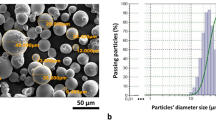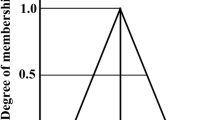Abstract
Laser metal deposition (LMD) process is an additive manufacturing technique that has attracted the interest of the automotive and aerospace industries due to its ability to manufacture parts with complex geometries and different types of metallic materials. However, the structure of the deposited layers and the geometrical characteristics of the manufactured parts are influenced by the interaction among the deposition process parameters. In this paper, fuzzy inference (FIS) technique was used to develop two models for predicting the geometrical characteristics and for optimizing the LMD process parameters. LMD was performed using AISI 316 stainless steel powder and substrate. An experimental design, based on factorial analysis, was used to correlate the influence of selected deposition process parameters, laser power (Lp), powder flow (Pf) and focal length (Fl) with the process geometrical characteristics bead height (Bh), bead width (Bw), depth of penetration (Dp), dilution (d) and wetting angle (wa). The factors Lp and Fl were used with three operating levels each, and the factor Pf was used with two operating levels. An analysis of variance allowed identifying that the Pf affects the Bh, Bh/Bw ratio, d and wa, as well as the increase in Lp showed an increasing of the geometric characteristics Bw and Dp. The first FIS, for predicting the bead’s geometrical characteristics, presented high adequacy (error up to 8.43%) for assessing the experimental conditions. The second FIS showed through the output defuzzified index (ODI) measured the best possible process parameters interaction, given the studied operating conditions and the output variables assessed.
















Similar content being viewed by others
Availability of data and materials
The data that support the findings of this work are available on request from the corresponding author.
References
Karunakaran K, Suryakumar S, Pushpa V, Akula S (2010) Low cost integration of additive and subtractive processes for hybrid layered manufacturing. Robot C-Integ Manufac 26:490–499. https://doi.org/10.1016/j.rcim.2010.03.008
Newman ST, Zhu Z, Dhokia V, Shokrani A (2015) Process planning for additive and subtractive manufacturing technologies. CIRP Ann – Manuf Technol 64:467–470. https://doi.org/10.1016/j.cirp.2015.04.109
Flynn J, Shokrani A, Newman ST, Dhokia V (2016) Hybrid additive and subtractive machine tools – research and industrial developments. Int J Mach Tools Manuf 101:79–101. https://doi.org/10.1016/j.ijmachtools.2015.11.007
Cortina M, Arrizubieta JI, Ruíz J, Ukar E, Lamikiz A (2018) Latest developments in industrial hybrid machine tools that combine additive and subtractive operations. Mater. 11:1–27. https://doi.org/10.3390/ma11122583
Herzog D, Seyda V, Wycisk E, Emmelmann C (2016) Additive manufacturing of metals. Acta Mater 117:371–392. https://doi.org/10.1016/j.actamat.2016.07.019
Liverani E, Toschi S, Ceschini L, Fortunato A (2017) Effect of selective laser melting (SLM) process parameters on microstructure and mechanical properties of 316L austenitic stainless steel. J Mater Process Technol 249:255–263. https://doi.org/10.1016/j.jmatprotec.2017.05.042
Shipley H, McDonnell D, Culleton M, Coull R, Lupoi R, O'Donnell G, Trimble D (2018) Optimisation of process parameters to address fundamental challenges during selective laser melting of Ti-6Al-4V: A review. Int J Mach Tools Manuf 128:1–20. https://doi.org/10.1016/j.ijmachtools.2018.01.003
Gu D, Xia M, Dai D (2019) On the role of powder flow behavior in fluid thermodynamics and laser processability of Ni-based composites by selective laser melting. Int J Mach Tools Manuf 137:67–78. https://doi.org/10.1016/j.ijmachtools.2018.10.006
Murkute P, Pasebani S, Isgor OB (2019) Production of corrosion-resistant 316L stainless steel clads on carbon steel using powder bed fusion-selective laser melting. J Mater Process Technol 273:116243. https://doi.org/10.1016/j.jmatprotec.2019.05.024
Morgan D, Agba E, Hill C (2017) Support structure development and initial results for metal powder bed fusion additive manufacturing. Procedia Manuf 10:819–830. https://doi.org/10.1016/j.promfg.2017.07.083
Dutta B, Palaniswamy S, Choi J, Lj S, Mazumder J (2011) Additive manufacturing by direct metal deposition. Adv Mater Process 169:33–36
Schmidt M, Merklein M, Bourell D, Dimitrov D, Hausotte T, Wegener K, Overmeyer L, Vollertsen F, Levy GN (2017) Laser based additive manufacturing in industry and academia. CIRP Ann – Manuf Technol 66:561–583. https://doi.org/10.1016/j.cirp.2017.05.011
Lee H-K (2008) Effects of the cladding parameters on the deposition efficiency in pulsed Nd:YAG laser cladding. J Mater Process Technol 202:321–327. https://doi.org/10.1016/j.jmatprotec.2007.09.024
Sun Y, Hao M (2012) Statistical analysis and optimization of process parameters in Ti6Al4V laser cladding using Nd: YAG laser. Opt Lasers Eng 50:985–995. https://doi.org/10.1016/j.optlaseng.2012.01.018
Graf B, Ammer S, Gumenyuk A, Rethmeier M (2013) Design of experiments for laser metal deposition in maintenance, repair and overhaul applications. Procedia CIRP 11:245–248. https://doi.org/10.1016/j.procir.2013.07.031
Farahmand P, Kovacevic R (2014) Parametric study and multicriteria optimization in laser cladding by a high power direct diode laser. Lasers Manuf Mater Process 1:1–20. https://doi.org/10.1007/s40516-014-0001-0
Liu S, Kovacevic R (2014) Statistical analysis and optimization of processing parameters in high-power direct diode laser cladding. Int J Adv Manuf Technol 74:867–878. https://doi.org/10.1007/s00170-014-6041-y
Yu T, Zhao Y, Sun J, Chen Y, Qu W (2018) Process parameters optimization and mechanical properties of forming parts by direct laser fabrication of YCF101 alloy. J Mater Process Technol 262:75–84. https://doi.org/10.1016/j.jmatprotec.2018.06.023
Wu J, Liu T, Chen H, Lia F, Wei H, Zhang Y (2019) Simulation of laser attenuation and heat transport during direct metal deposition considering beam profile. J Mater Process Technol 270:92–105. https://doi.org/10.1016/j.jmatprotec.2019.02.021
Huang Y, Ansari M, Asgari H, Hossein M, Farshidianfar MH, Sarker D, Khamesee MB, Toyserkani E (2019) Rapid prediction of real-time thermal characteristics, solidification parameters and microstructure in laser directed energy deposition (powder-fed additive manufacturing). J Mater Process Technol 274:116286. https://doi.org/10.1016/j.jmatprotec.2019.116286
Ansari M, Mohamadizadeh A, Huang Y, Paserin V, Toyserkani E (2019) Laser directed energy deposition of water-atomized iron powder: process optimization and microstructure of single-tracks. Opt L Technol 112:485–493. https://doi.org/10.1016/j.optlastec.2018.11.054
Nagesh DS, Datta GL (2002) Prediction of weld bead geometry and penetration in shielded metal-arc welding using artificial neural networks. J Mater Process Technol 123:303–312. https://doi.org/10.1016/S0924-0136(02)00101-2
Supriadi S, Manabe K (2013) Enhancement of dimensional accuracy of dieless tube-drawing process with vision-based fuzzy control. J Mater Process Technol 213:905–912. https://doi.org/10.1016/j.jmatprotec.2012.12.011
Lin JL, Lin CL (2005) The use of grey-fuzzy logic for the optimization of the manufacturing process. J Mater Process Technol 160:9–14. https://doi.org/10.1016/j.jmatprotec.2003.11.040
Wu BH, Wang J-JJ (2009) A neuro-fuzzy approach to generating mould/die polishing sequences. J Mater Process Technol 209:3241–3250. https://doi.org/10.1016/j.jmatprotec.2008.07.031
Tan H, Tarasov V, Jarfors AEW, Seifeddine S (2021) A design of fuzzy inference systems to predict tensile properties of as-cast alloy. Int J Adv Manuf Technol 113:1111–1123. https://doi.org/10.1007/s00170-020-06502-4
Genna S, Lambiase F, Ponticelli GS (2020) Fuzzy decision-making in laser-assisted joining of polymer-metal hybrid structures. Int J Adv Manuf Technol 108:61–72. https://doi.org/10.1007/s00170-020-05379-7
Tasé Velázquez DR, Luís Helleno A, de Oliveira MC, Carvajal Fals H, Jimenez Macias E (2020) Fuzzy logic-based inference system for prediction of energy input in laser metal deposited AISI316 single-beads. In: 32nd European Modeling & Simulation Symposium proceedings (EMSS 2020), September 16-18. Athens, Greece, pp 400-409. https://doi.org/10.46354/i3m.2020.emss.058
Indústrias ROMI. ROMI DCM 620-5X HYBRID Technical specifications. Available in: https://www.romi.com/wp-content/uploads/2017/10/fol_romi_dcm_hybrid_po_aa_052017_baixa.pdf. Access February 2019.
Alam M, Urbanic R, Nazemi N, Edrisy A (2018) Predictive modeling and the effect of process parameters on the hardness and bead characteristics for laser-cladded stainless steel. Int J Adv Manuf Technol 94:397–413. https://doi.org/10.1007/s00170-017-0898-5
Rao PS, Gupta OP, Murty SSN, Rao ABK (2009) Effect of process parameters and mathematical model for the prediction of bead geometry in pulsed GMA welding. Int J Adv Manuf Technol 45:496–505. https://doi.org/10.1007/s00170-009-1991-1
Caiazzo F (2018) Laser-aided Directed Metal Deposition of Ni-based superalloy powder. Opt L Technol 103:193–198. https://doi.org/10.1016/j.optlastec.2018.01.042
Calleja A, Tabernero I, Fernández A, Celaya A, Lamikiz A, López de Lacalle LN (2014) Improvement of strategies and parameters for multi-axis laser cladding operations. Opt L Eng 56:113–120. https://doi.org/10.1016/j.optlaseng.2013.12.017
Latha B, Senthilkumar VS (2010) Modeling and analysis of surface roughness parameters in drilling GFRP composites using fuzzy logic. Mater Manuf Process 25:817–827. https://doi.org/10.1080/10426910903447261
Gomide FC, Gudwin R, Tanscheit R (1995) Conceitos fundamentais da teoria de conjuntos fuzzy, lógica fuzzy e aplicações. In: Proc. 6th IFSA Congress-Tutorials, pp. 1–38.
Zadeh LA (1965) Fuzzy Sets. Inf Control 8:338–353. https://doi.org/10.1016/S0019-9958(65)90241-X
Mamdani E, Assilian S (1975) An experiment in linguistic synthesis with a fuzzy logic controller. Int J Man Mach Stud 7:1–13. https://doi.org/10.1016/S0020-7373(75)80002-2
Saade JJ, Diab HB (2004) Defuzzification methods and new techniques for fuzzy controllers. I J Elect Comp Eng 3:161–174 Available in: https://pdfs.semanticscholar.org/8781/b6f848e356eff46f3160efb3d0b5d50d077c.pdf. Access March 2019
Zimmermann H-J (2001). Fuzzy set theory and its applications. 4th ed. Springer Science + Business Media New York.
Das B, Roy S, Rai RN, Saha SC (2016) Application of grey fuzzy logic for the optimization of CNC milling parameters for Al–4.5%Cu–TiC MMCs with multi-performance characteristics. Eng Sci Technol I J 19:857–865
Acknowledgements
The authors would like to thank the Higher Education Personnel Improvement Coordination – Brazil (CAPES - Coordenação de Aperfeiçoamento de Pessoal de Nível Superior) which financed this study in part - Finance Code 001. In addition, the authors would like to thank the ROMI Industry for allowing the open and wide access to their facilities for studying the hybrid system ROMI DCM 620-5X HYBRID.
Author information
Authors and Affiliations
Contributions
Daniel René Tasé Velázquez designed and implemented the fuzzy models and analysed the results. André Luís Helleno designed the experiments, helped verify the results and supervised the project. Hipólito Carvajal Fals helped to collect the data and measurements. Raphael Galdino dos Santos helped to perform the tests, collect data and verify the results. All authors discussed the results and contributed to the final manuscript.
Corresponding author
Ethics declarations
Ethics approval
Not applicable
Consent to participate
Not applicable
Consent for publication
Not applicable
Conflict of interest
The authors declare no competing interests.
Additional information
Publisher’s note
Springer Nature remains neutral with regard to jurisdictional claims in published maps and institutional affiliations.
Rights and permissions
About this article
Cite this article
Velázquez, D.R.T., Helleno, A.L., Fals, H.C. et al. Prediction of geometrical characteristics and process parameter optimization of laser deposition AISI 316 steel using fuzzy inference. Int J Adv Manuf Technol 115, 1547–1564 (2021). https://doi.org/10.1007/s00170-021-07269-y
Received:
Accepted:
Published:
Issue Date:
DOI: https://doi.org/10.1007/s00170-021-07269-y




